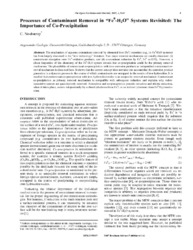Processes of Contaminant Removal in Fe0-H2O Systems Revisited: The Importance of Co-Precipitation
Zeitschrift: The @open environmental journal, 20071: 9 - 13
Noubactep, Chicgoua, 2007: Processes of Contaminant Removal in Fe0-H2O Systems Revisited: The Importance of Co-Precipitation. In: The @open environmental journal, Band 1: 9 - 13, DOI: 10.23689/fidgeo-2425.
 |
Dokument öffnen: |
The mechanism of aqueous contaminant removal by elemental iron (Fe0) materials (e.g., in Fe0-H2O systems) has been largely discussed in the iron technology literature. Two major removal mechanisms are usually discussed: (i) contaminant adsorption onto Fe0 oxidation products, and (ii) contaminant reduction by Fe0, FeII or H/H2. However, a closer inspection of the chemistry of the Fe0-H2O system reveals that co-precipitation could be the primary removal mechanism. The plausibility of contaminant co-precipitation with iron corrosion products as independent contaminant removal mechanism is discussed here. It shows that the current concept does not take into account that the corrosion product generation is a dynamic process in the course of which contaminants are entrapped in the matrix of iron hydroxides. It is recalled that contaminant co-precipitation with iron hydroxides/oxides is an unspecific removal mechanism. Contaminant co-precipitation as primary removal mechanism is compatible with subsequent reduction and explains why redoxinsensitive species are quantitatively removed. Adsorption and co-precipitation precede reduction and abiotic reduction, when it takes place, occurs independently by a direct (electrons from Fe0) or an indirect (electrons from FeII/H2) mechanism.
Statistik:
ZugriffsstatistikSammlung:
- Geologie [930]

